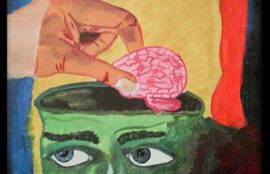
What would a healthy world economy look like?
With me, it all comes down to biology. I took a lot of courses in physiology while I was in grad school studying for a Masters in Bioengineering. As a former Catholic priest, I also have a Master of Divinity degree. But for me, when I understand something on a physical/biological level, I really get it.
My plum research assignment when I was studying bioengineering was to work in Penn State’s artificial heart lab. We tested our heart pumps in the earliest stages of development using a “mock circulatory system” developed by a genius member of the faculty named Gus Rosenberg. I won’t get into the nitty gritty details (or the sticky, viscous, messiness of the blood substitute glycerin when the system sprung a leak).
There are four key aspects to the system that delivers blood to the human body: A pumping mechanism, capacitance, resistance, and the blood vessels themselves (rubber tubing in the mockup).
The pump in the circulatory system is obvious—it’s the heart. It provides the energy needed to push the blood to all parts of the body, delivering oxygen to tissues, from the brain to the toes; then the return journey from all part of the body back to the lungs where the blood picks up oxygen and returns to the heart to start the routine again.
In order to get blood get back and forth though the smallest capillaries, the heart has to fight against resistance. In this world we live in, there is always resistance. Think of gravity. In the mock system, resistance is provided by a junction where a one-inch tube becomes several quarter-inch tubes. (I don’t remember the exact dimensions. Gus forgive me.) The capillary tubes are located between two metal plates with turnscrews that can increase or decrease the resistance.
The heart pumps blood in a rhythmic pattern. That is the reason why our blood pressure is measured in systolic pressure and diastolic pressure. In order for the flow to be manageable in the body, the up and down pressure has to be smoothed out in some way. It is like chugging a drink instead of slowly drinking it. At the very least, chugging will make you take in a lot of air leading to belching, stomach aches, and possibly passing beer through your nostrils. The blood vessel’s capacity to absorb and smooth out blood flow is crucial. They do this by expanding and contracting.
In the mock circulatory system, capacitance is provided by a cylinder with an inlet and an outlet, on both the supply and return sides of the system. When the heart pumps, the reservoir fills quickly but drains out more slowly. It’s like taking in a big breath and then letting it our more smoothly. Or think of an airplane cycling between high speed and low speed. It wouldn’t stay in the air for long.
The Heart of the Global Economy
So what can the dynamics of a circulatory system say about the world economy?
Think of the heart as the energy of the economy, the creating and distribution of goods and services. Think of the capacitors as banks that take the swings of the market forces and pass it on, through loans and investments, in a controlled and predicable manner. Like a body, the economic system does not like sudden increases and decreases in capitol. Banks, like capacitors, offer securities as a way for investors to guard against the sudden rising and falling of the market.
In today’s global economy, the vessels are all the ways capital flows around the system—mostly now through the internet and trading floors. And finally, the resistance is provided, in a healthy system, by the gradual movement of capitol from banks to investors, and corporations, down to small businesses and individual mortgages and savings accounts. So the whole body is able to benefit from the energy of the heart.
A healthy global economy, like a healthy body, efficiently directs the flow of capital to nourish the whole body. In this case the body includes the heart, which gets the first freshly oxygenated blood through the coronary arteries. The heart of the economic system is the energy of those creating and selling goods and services.
In an unhealthy body, blood flow does not get to the heart because of blocked coronaries and high blood pressure. So too in the global economy. When money remains largely in the financial markets, in the banks and the big investment houses, the dynamics of the system slow and the people who make goods and offer services are not fed with the capitol they need to thrive. And like in the far-flung parts of the body, the fingers and the toes, when the flow of capitol doesn’t reach the farmer in Kenya or the small businesswoman in Egypt, or in Iowa, the whole system begins to die. People with uncontrolled diabetes resulting in a lack of blood flow into their extremities die in parts. (I’ve known people who lost toes, then feet, then legs, then they died.)
An economy cannot ultimately flourish when segments of the economy are left to wither and die. This leads to famine, a lack of meaningful work, homelessness, and poverty; millions of refugees fleeing dangerous areas looking for safety for themselves and their families. Like a body, a global economy, if not serving all parts of the system, will die in parts too. And an unhealthy global economy is in no position to handle crisis such as Global Climate Change and pandemics such as COVID-19.
The Distribution Resolution
For example, in an efficient global economy, personal protective equipment (PPE) would be distributed efficiently all over the globe to health care workers, food handlers, schools and other crucial service providers. Instead, in the United States, the states are bidding against other states for the equipment they need. And profiteers, as during wartime, suck capitol from the system without contributing to solving the problems many of them have produced. Storehouses all over the world are full of weapons systems that are paid for but should never be used. Ordinary people hoard toilet paper, creating a crisis in bathrooms all over the world!
We don’t have a supply problem in this world. We have a distribution problem.
Another example of the importance of a healthy global economy is the worldwide response to Global Climate Change. The increased levels of carbon dioxide in the atmosphere during the last century or so acts like a layer of insulation, keeping too much energy in the weather system, leading to floods and droughts, fires, and famine. A functioning, global carbon trading system would gradually reduce the amount of greenhouse gases emitted into the atmosphere. And a carbon tax could do the same.
The way I’ve presented both the human circulatory system and the global economy is simplistic and does not go into great detail. That’s why the world needs wise cardiologists and smart and compassionate economists. We need responsible political leaders that are able to cooperate with other leaders to bring the best minds to the biggest challenges. I think we have the first two covered. In the United States and around the world, universities and medical schools train the best and the brightest, who provide crucial advice to governments and business and offer high quality care to patients with cardiac and other diseases. (The availability of quality education and training for everyone is another story.)
Political leadership, at least in this country and notable others, is not so great; in fact, right now it’s abysmal, corrupt and dysfunctional. Look at the dismantling of the Post Office, it’s own kind of distribution system for a functioning economy. So vote!
About the Author:

Ascension Lifestyle Contributor Jim Gunshinan was in turn Assistant Editor, Managing Editor, Editor, and Senior Editor at Home Energy Magazine/Building Performance Journal for 20 years. He is now a freelance writer and editor who explores life through personal essays, poetry, and other things that pay the bills.






















Sorry, the comment form is closed at this time.